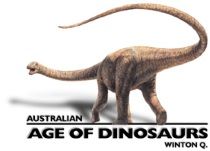THE JUMP-UP

Australian Age of Dinosaurs is located on 1,801.7 hectares of rugged mesa plateau or jump-up. The Jump-Up is approximately 270m above sea level, stands 75m above the surrounding land and forms part of a mesa formation called the Vindex Range. Like much of the Winton Shire, The Jump-Up is part of the Winton Formation, which is dated around 95–98 million years old. As the cap-rock surface of The Jump-Up is solid rock it has resisted erosion throughout a period of deep weathering that has eroded the surrounding countryside.
In 2018 The Jump-Up, Maloney Lodge and the Ultimate Dinosaur Tour successfully achieved Nature Tourism certification through Ecotourism Australia.
The site was selected to meet the following criteria:
- Wilderness setting
- Visual attractiveness
- Proximity to a major highway
- Proximity (two hours’ drive) to Longreach airport and railway station
- Excellent building foundations
- Ample room for future planning and expansion
- Multiple additional attractions including bird watching, bushwalking, photography, painting, stargazing etc
- Geological and palaeontological relevance
- Existing visitor infrastructure and facilities at Winton and Longreach
- Freehold tenure
Photos by T Sloan
DISTRICT
The Winton district was chosen for the Museum site for the following reasons:
Winton Shire has produced more fossil material from large dinosaurs than any other region in Australia. It also has the potential to produce these fossils well into the foreseeable future with several new sites being discovered each year.
Current discovery rates far exceed capacity to recover and prepare this material and the region’s abundance of fossils will fill an important role in sustainable development of the Museum over the next 50 years and more.
Winton is centred in the Winton Formation, a geological land formation formed approximately 95 million years ago from sand and silt deposited by rivers and streams into a retreating inland sea. The blacksoil downs surrounding Winton are merely the weathered remnants of this ancient deposit. Visitors stand on the same earth that held up the mighty dinosaurs around 100 million years ago. The climate, the animals and the environment were very different but the blacksoil dust that is so characteristic of the district today was the same. This being "on the spot" adds another dimension to the dinosaur experience.
Winton is in close proximity to Lark Quarry Dinosaur Stampede, a National Heritage Listed Monument internationally acclaimed as the best example of running dinosaur tracks in the world. Winton is also a major gateway to regional fossil displays at Mt Isa, Boulia, Isisford, Hughenden and Richmond. These combined attractions make the district a comprehensive destination.
CONSERVATION
This project will prevent the current degradation (by feral animals and noxious weeds) of a unique mesa environment that is poorly represented in western Queensland. It will also help protect the habitat and diversity of numerous native plants and animals, many of which are rare in the area and survive in the uniquely sheltered mesa environment.
EDUCATION
Natural history and cultural heritage tours and interpretations promote public awareness of this valuable natural asset and educate children and visitors in conservation and sustainability issues.
SUSTAINABILITY
Construction of mesa facilities will be based on best practices, making use of innovative environmental advancements wherever possible. This includes wind and solar-generated electricity and water pumping; nature-assisted climate control and environmentally friendly waste management systems.
DINOSAURS TO DUNNARTS PROGRAM
The Jump-Up is like an island in the desert and home to many species not found on the surrounding plains. Its many habitats and microclimates make it richly biodiverse. The Dinosaurs to Dunnarts program seeks to document the flora and fauna of our beautiful 4,500-acre site. Visitors are invited to help by sending us digital photos of what they find while here. The animals and plants photographed will be identified by specialists assisting the program.
Click the map below to find a list of the plants found on and near The Jump-Up. Have you taken a photo of a plant that doesn't appear on the list? Send an email to operations@aaod.com.au and we will attempt to identify it for you.

